



Visual Literacy: An E-Learning Tutorial on Visualization for Communication, Engineering and Business Visual Cards for Collaboration and Team Creativity Making the Complex Clear Visual Literacy for Managers - How Sketching enables Visual Problem Solving and Communication (get the hardcopy edition at sketchingatwork.com) By clicking on a map or diagram thumbnail below, you can access an interactive graphic overview on tools, books, researchers in different visualization fields, as well as on key success factors of visualization. Stairs to visual excellence "Towards A Periodic Table of Visualization Methods for Management"Lengler R., Eppler M. (2007). Version 1.5 of the periodic table as PDF Chris Wallace has implemented an XML page on which you can see and print the mouseover pictures individually. On another page by Chris you can group the visualization methods by your criteria and you can find background information for a specific visualization method via 'Google Images' and 'Wikipedia'. Imperfect Storm (Click on image to enlarge)
moviebarcode moviebarcode contact | twitter | index | prints 2014/04/12 28 notes The Karate Kid, Part III (1989) 2014/04/11 144 notes The Hunger Games: Catching Fire (2013) 2014/04/10 35 notes The Mark of Zorro (1940) 2014/04/09 20 notes Flandersui gae / Barking Dogs Never Bite (2000) 2014/04/08 41 notes The Last Airbender (2010) 2014/04/07 21 notes Il mio nome è Nessuno / My Name Is Nobody (1973) 2014/04/06 122 notes Cowboy Bebop: Tengoku no tobira / Cowboy Bebop: The Movie (2001) 2014/04/05 18 notes Jing wu ying xiong / Fist of Legend (1994) 2014/04/04 176 notes Despicable Me 2 (2013) 2014/04/03 21 notes Cinema Jenin: The Story of a Dream (2011) 1 2 3 4 5 6 7 8 9 10 Next » clear theme by parti powered by tumblr
The Work of Edward Tufte and Graphics Press Edward Tufte is a statistician and artist, and Professor Emeritus of Political Science, Statistics, and Computer Science at Yale University. He wrote, designed, and self-published 4 classic books on data visualization. The New York Times described ET as the "Leonardo da Vinci of data," and Business Week as the "Galileo of graphics." He is now writing a book/film The Thinking Eye and constructing a 234-acre tree farm and sculpture park in northwest Connecticut, which will show his artworks and remain open space in perpetuity. He founded Graphics Press, ET Modern gallery/studio, and Hogpen Hill Farms LLC. Visual Display of Quantitative Information 200 pages Envisioning Information 128 pages Visual Explanations 160 pages Beautiful Evidence 214 pages Same paper and printing as in original clothbound editions. All 4 clothbound books, autographed by author $150 Available directly from Graphics Press. Die visuelle Darstellung quantitativer Informationen, (200 Seiten), $12 数量情報の視覚的表示, (200 ページ)、$12
CINEMETRICS — film data visualization JESS3™ Masters of Media 10 Outstanding Social Media Infographics | @NowSourcing.Com Nobody has time to read anymore, right? Every day we are all inundated with more and more information overload coming from credible and yet to be verified sources. Where can Internet users find relief? Answer: the infographic. Infographics are a wonderful mix of key data and visualization that can really bring the message home if put together correctly. So without further ado, we bring you our top 10 favorite social media infographics! Update: Check out our infographic design services 1 – World Map of Social Networks Let’s start at the 50,000 foot view, shall we? (Source) 2 – Age Distribution on Social Network Sites Is age distribution targeting more your thing? (Source) 3 – Social Media Periodic Table of Elements As we previously reported, our friend and fellow Advertising Age Power 150 member Eyecube created another great visualization called the social media periodic table of elements: (Source) 4 – The Conversation Prism 5 – The Boom of Social Sites (Source) (Source) 7 – Hubspot Twitter Territory
Collaborative Cybernetics | Olivier H. Beauchesne Visualisation Insights: #1 The visualisation designer This post is the first in a series I am commencing called Visualisation Insights. The purpose of this series is to provide readers with unique insights into the field of visualisation from the different perspectives of those in the roles of designer, practitioner, academic, blogger, journalist and all sorts of other visual thinkers. My aim is to bring together these interviews to create a greater understanding and appreciation of the challenges, approaches and solutions that exist in the worlds of this collection of people – the visualisation field’s ‘cast and crew’. I will be following each interview with a post reflecting on some of the key insights to emerge. One of the most shared and discussed visualisation designs was conceived, designed and produced by New York designer Michael Deal on behalf of Umbro, the UK sportswear brand. [click image for large view] You can see more of Michael’s personal work at www.mikemake.com. How would you describe your interest in football?
Blog | Doing Digital Humanities (S13) The following “Blessay” post is an edited version of an earlier post I wrote on 02/13/2013 — “Toward a Student-Centered Collaborative Approach to DH Design — The ECDA’s Omeka Installation as a “Knowledge Lab” —which I had intended to submit as my “Blessay,” but failed to do so correctly. Across the semester I have been interested in a discussion of how the field of DH conceives of students (graduate and undergraduate) as not just eventual end-“users” of the DH projects scholars “build” but as potential, perhaps necessary co-contributors/collaborators in the “doing” and “making” practices of the field. In what follows, I want examine the need for DH, which is already characteristically a collaborative endeavor, to seek out new ways for involving students more directly in its scholarly “building” practices. I want to begin with Stephen Ramsay’s rather controversial statement over “Who’s In and Who’s Out” of the DH field.